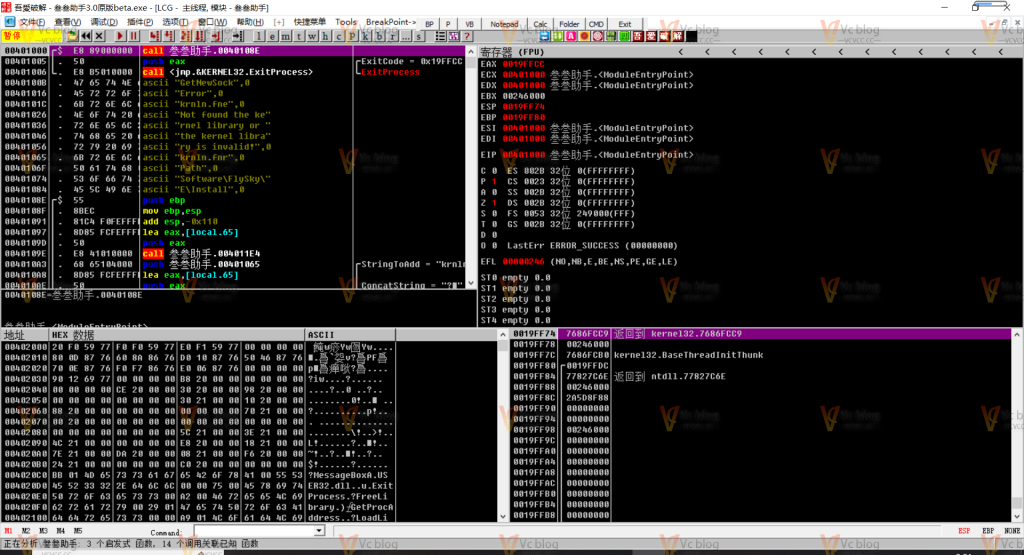函数是Python编程的核心构建块,但很多开发者在参数传递、作用域管理和高级函数特性上会遇到各种困惑。本文将深入解析Python函数的工作原理,帮助你避开常见陷阱,写出更健壮、可维护的代码。
![图片[1]-Python函数深度解析:参数传递、作用域与Lambda表达式实战](https://blogimg.vcvcc.cc/2025/11/20251111130914540-1024x768.png?imageView2/0/format/webp/q/75)
一、函数参数传递的陷阱与解决方案
1. 可变参数与不可变参数的差异
问题现象:
def update_number(x):
x = x + 10
print(f"函数内 x = {x}")
def update_list(lst):
lst.append(4)
print(f"函数内 lst = {lst}")
# 测试
num = 5
print(f"调用前 num = {num}")
update_number(num)
print(f"调用后 num = {num}") # 仍然是5!
my_list = [1, 2, 3]
print(f"调用前 my_list = {my_list}")
update_list(my_list)
print(f"调用后 my_list = {my_list}") # 被修改了!输出结果:
调用前 num = 5
函数内 x = 15
调用后 num = 5
调用前 my_list = [1, 2, 3]
函数内 lst = [1, 2, 3, 4]
调用后 my_list = [1, 2, 3, 4]问题分析:
- Python参数传递是”对象引用传递”
- 不可变对象(数字、字符串、元组):函数内修改不会影响原始对象
- 可变对象(列表、字典、集合):函数内修改会影响原始对象
解决方案:
# 方案1:返回新对象而不是修改参数
def safe_update_list(lst):
new_list = lst.copy() # 创建副本
new_list.append(4)
return new_list
original_list = [1, 2, 3]
new_list = safe_update_list(original_list)
print(f"原列表: {original_list}") # [1, 2, 3]
print(f"新列表: {new_list}") # [1, 2, 3, 4]
# 方案2:使用不可变对象作为默认参数
def process_data(data=None):
if data is None:
data = [] # 每次调用创建新列表
data.append("processed")
return data
print(process_data()) # ['processed']
print(process_data()) # ['processed'] 而不是 ['processed', 'processed']
# 方案3:明确文档说明函数是否会修改参数
def add_to_list(lst, item):
"""
向列表添加元素(会修改原列表)
Args:
lst: 要修改的列表
item: 要添加的元素
Returns:
None: 直接修改原列表
"""
lst.append(item)
def create_new_list(lst, item):
"""
创建包含新元素的列表(不修改原列表)
Args:
lst: 原列表
item: 要添加的元素
Returns:
list: 新的列表
"""
return lst + [item]2. 默认参数的可变陷阱
问题代码:
# 反模式:可变对象作为默认参数
def add_item(item, items=[]): # 危险!默认参数在函数定义时创建
items.append(item)
return items
print(add_item(1)) # [1]
print(add_item(2)) # [1, 2] - 不是预期的[2]!
print(add_item(3)) # [1, 2, 3] - 越来越长!解决方案:
# 正确做法:使用None作为默认值
def add_item(item, items=None):
if items is None:
items = [] # 在函数内部创建新列表
items.append(item)
return items
print(add_item(1)) # [1]
print(add_item(2)) # [2] - 符合预期
print(add_item(3)) # [3] - 符合预期
# 对于字典同样适用
def create_user(name, extra_data=None):
if extra_data is None:
extra_data = {}
user = {"name": name, **extra_data}
return user
user1 = create_user("Alice")
user2 = create_user("Bob")
print(user1) # {'name': 'Alice'}
print(user2) # {'name': 'Bob'}二、变量作用域详解
1. 局部作用域 vs 全局作用域
问题现象:
x = 10 # 全局变量
def function1():
print(f"函数内访问全局变量: {x}") # 可以读取
def function2():
x = 20 # 创建新的局部变量,不是修改全局变量
print(f"函数内局部变量: {x}")
def function3():
global x # 声明使用全局变量
x = 30 # 修改全局变量
print(f"修改后的全局变量: {x}")
print(f"初始全局变量: {x}") # 10
function1() # 函数内访问全局变量: 10
function2() # 函数内局部变量: 20
print(f"function2调用后全局变量: {x}") # 10 - 未改变
function3() # 修改后的全局变量: 30
print(f"function3调用后全局变量: {x}") # 30 - 已改变2. nonlocal关键字的使用
问题场景:
def outer_function():
count = 0
def inner_function():
# 这里想要修改外部函数的count变量
count += 1 # UnboundLocalError!
return count
return inner_function
counter = outer_function()
print(counter()) # 报错!解决方案:
def outer_function():
count = 0
def inner_function():
nonlocal count # 声明使用外部函数的变量
count += 1
return count
return inner_function
# 使用闭包
counter = outer_function()
print(counter()) # 1
print(counter()) # 2
print(counter()) # 3
# 另一个实用例子:状态保持
def create_account(initial_balance=0):
balance = initial_balance
def deposit(amount):
nonlocal balance
balance += amount
return balance
def withdraw(amount):
nonlocal balance
if amount <= balance:
balance -= amount
return balance
else:
return "余额不足"
def get_balance():
return balance
return {
"deposit": deposit,
"withdraw": withdraw,
"get_balance": get_balance
}
# 使用账户
account = create_account(100)
print(account["get_balance"]()) # 100
print(account["deposit"](50)) # 150
print(account["withdraw"](30)) # 120
print(account["get_balance"]()) # 1203. 作用域链解析
# LEGB规则:Local -> Enclosing -> Global -> Built-in
x = "global" # Global
def outer():
x = "enclosing" # Enclosing
def inner():
x = "local" # Local
print(f"Local x: {x}")
def deepest():
# 这里没有定义x,会查找Enclosing作用域
print(f"Deepest找到的 x: {x}") # 来自inner的local
deepest()
inner()
print(f"Outer的 x: {x}")
outer()
print(f"Global的 x: {x}")
# 输出:
# Local x: local
# Deepest找到的 x: local
# Outer的 x: enclosing
# Global的 x: global三、Lambda表达式实战技巧
1. Lambda基础与适用场景
基本语法:
# 传统函数定义
def square(x):
return x ** 2
# Lambda等价形式
square_lambda = lambda x: x ** 2
print(square(5)) # 25
print(square_lambda(5)) # 25
# Lambda的典型使用场景
numbers = [1, 2, 3, 4, 5]
# 1. 与map()配合使用
squared = list(map(lambda x: x ** 2, numbers))
print(squared) # [1, 4, 9, 16, 25]
# 2. 与filter()配合使用
evens = list(filter(lambda x: x % 2 == 0, numbers))
print(evens) # [2, 4]
# 3. 与sorted()配合使用
students = [
{"name": "Alice", "grade": 85},
{"name": "Bob", "grade": 92},
{"name": "Charlie", "grade": 78}
]
# 按成绩排序
sorted_students = sorted(students, key=lambda student: student["grade"])
print([s["name"] for s in sorted_students]) # ['Charlie', 'Alice', 'Bob']2. Lambda的常见陷阱
陷阱1:延迟绑定问题
# 反模式:在循环中创建lambda
functions = []
for i in range(3):
functions.append(lambda: i) # 所有lambda都引用同一个i
print([f() for f in functions]) # [2, 2, 2] 不是预期的[0, 1, 2]!解决方案:
# 方案1:使用默认参数捕获当前值
functions = []
for i in range(3):
functions.append(lambda i=i: i) # 使用默认参数
print([f() for f in functions]) # [0, 1, 2] - 正确!
# 方案2:使用functools.partial
from functools import partial
functions = []
for i in range(3):
functions.append(partial(lambda x: x, i))
print([f() for f in functions]) # [0, 1, 2]
# 方案3:使用生成器表达式
functions = [lambda x=i: x for i in range(3)]
print([f() for f in functions]) # [0, 1, 2]陷阱2:复杂逻辑滥用Lambda
# 反模式:在lambda中写复杂逻辑
result = (lambda x:
x ** 2 if x > 0 else
(0 if x == 0 else
"负数不能平方"))(5)
# 应该使用普通函数
def calculate_square(x):
if x > 0:
return x ** 2
elif x == 0:
return 0
else:
return "负数不能平方"
print(calculate_square(5)) # 更清晰3. Lambda高级用法
# 1. 在字典排序中的高级应用
data = [
{"name": "Alice", "age": 25, "city": "New York"},
{"name": "Bob", "age": 30, "city": "London"},
{"name": "Charlie", "age": 25, "city": "Paris"}
]
# 多级排序:先按年龄,再按城市
sorted_data = sorted(data, key=lambda x: (x["age"], x["city"]))
for item in sorted_data:
print(f"{item['name']} - {item['age']} - {item['city']}")
# 2. 在reduce中的使用
from functools import reduce
numbers = [1, 2, 3, 4, 5]
product = reduce(lambda x, y: x * y, numbers)
print(f"乘积: {product}") # 120
# 3. 条件Lambda
def create_calculator(operation):
operations = {
"add": lambda x, y: x + y,
"subtract": lambda x, y: x - y,
"multiply": lambda x, y: x * y,
"divide": lambda x, y: x / y if y != 0 else "除零错误"
}
return operations.get(operation, lambda x, y: "未知操作")
calc = create_calculator("add")
print(calc(10, 5)) # 15四、闭包与装饰器实战
1. 闭包的实用场景
# 场景1:计数器工厂
def create_counter(initial=0):
count = initial
def increment(step=1):
nonlocal count
count += step
return count
def decrement(step=1):
nonlocal count
count -= step
return count
def reset():
nonlocal count
count = initial
return count
def get_count():
return count
return {
"increment": increment,
"decrement": decrement,
"reset": reset,
"get_count": get_count
}
# 使用计数器
counter1 = create_counter(10)
counter2 = create_counter(100)
print(counter1["increment"]()) # 11
print(counter1["increment"](5)) # 16
print(counter2["decrement"](10)) # 90
print(counter1["get_count"]()) # 16
print(counter2["get_count"]()) # 90
# 场景2:缓存装饰器
def memoize(func):
cache = {}
def wrapper(*args):
if args in cache:
print(f"缓存命中: {args}")
return cache[args]
print(f"计算: {args}")
result = func(*args)
cache[args] = result
return result
return wrapper
@memoize
def fibonacci(n):
if n <= 1:
return n
return fibonacci(n-1) + fibonacci(n-2)
print(fibonacci(5)) # 5
# 输出会显示缓存命中的情况,避免重复计算2. 装饰器进阶应用
import time
from functools import wraps
# 带参数的装饰器
def retry(max_attempts=3, delay=1):
def decorator(func):
@wraps(func) # 保留原函数信息
def wrapper(*args, **kwargs):
attempts = 0
while attempts < max_attempts:
try:
return func(*args, **kwargs)
except Exception as e:
attempts += 1
if attempts == max_attempts:
raise e
print(f"尝试 {attempts} 失败,{delay}秒后重试...")
time.sleep(delay)
return None
return wrapper
return decorator
# 使用带参数的装饰器
@retry(max_attempts=3, delay=2)
def unreliable_operation():
import random
if random.random() < 0.7: # 70%概率失败
raise ValueError("操作失败")
return "操作成功"
try:
result = unreliable_operation()
print(result)
except ValueError as e:
print(f"最终失败: {e}")
# 类装饰器
class Timer:
def __init__(self, func):
self.func = func
wraps(func)(self)
def __call__(self, *args, **kwargs):
start_time = time.time()
result = self.func(*args, **kwargs)
end_time = time.time()
print(f"函数 {self.func.__name__} 执行时间: {end_time - start_time:.4f}秒")
return result
@Timer
def slow_function():
time.sleep(1)
return "完成"
print(slow_function())五、函数式编程技巧
1. 高阶函数应用
from functools import reduce, partial
from operator import add, mul
# 函数组合
def compose(*functions):
def composed(arg):
for func in reversed(functions):
arg = func(arg)
return arg
return composed
# 创建数据处理管道
def preprocess_data(data):
# 去除空格,转为小写,分割单词
pipeline = compose(
lambda s: s.split(), # 分割单词
lambda s: s.lower(), # 转为小写
lambda s: s.strip() # 去除空格
)
return pipeline(data)
text = " Hello World Python Programming "
result = preprocess_data(text)
print(result) # ['hello', 'world', 'python', 'programming']
# 部分应用(Partial Application)
def power(base, exponent):
return base ** exponent
# 创建平方和立方函数
square = partial(power, exponent=2)
cube = partial(power, exponent=3)
print(square(5)) # 25
print(cube(3)) # 27
# 使用operator模块
numbers = [1, 2, 3, 4, 5]
# 替代lambda
sum_result = reduce(add, numbers)
product_result = reduce(mul, numbers)
print(f"总和: {sum_result}") # 15
print(f"乘积: {product_result}") # 1202. 生成器函数与yield
# 生成器函数 - 惰性计算
def fibonacci_generator(limit):
a, b = 0, 1
count = 0
while count < limit:
yield a
a, b = b, a + b
count += 1
# 使用生成器
print("斐波那契数列:")
for num in fibonacci_generator(10):
print(num, end=" ")
# 输出: 0 1 1 2 3 5 8 13 21 34
# 生成器表达式
squares = (x**2 for x in range(10))
print(f"\n平方数: {list(squares)}")
# 管道处理大数据
def read_large_file(file_path):
with open(file_path, 'r', encoding='utf-8') as file:
for line in file:
yield line.strip()
def filter_lines(lines, keyword):
for line in lines:
if keyword in line:
yield line
def transform_lines(lines, transform_func):
for line in lines:
yield transform_func(line)
# 构建处理管道
# lines = transform_lines(
# filter_lines(
# read_large_file("large_file.txt"),
# "python"
# ),
# str.upper
# )六、调试与性能优化
1. 函数调试技巧
import inspect
def debug_function(func):
def wrapper(*args, **kwargs):
print(f"调用函数: {func.__name__}")
print(f"参数: args={args}, kwargs={kwargs}")
# 获取源代码
try:
source = inspect.getsource(func)
print(f"函数源码:\n{source}")
except:
pass
result = func(*args, **kwargs)
print(f"返回值: {result}")
return result
return wrapper
@debug_function
def example_function(x, y, operation="add"):
if operation == "add":
return x + y
elif operation == "multiply":
return x * y
example_function(5, 3, operation="multiply")2. 性能考量
import timeit
# 测试Lambda vs 普通函数的性能
def square_func(x):
return x ** 2
square_lambda = lambda x: x ** 2
# 性能测试
numbers = list(range(1000))
# 测试map性能
func_time = timeit.timeit(
'list(map(square_func, numbers))',
globals=globals(),
number=1000
)
lambda_time = timeit.timeit(
'list(map(square_lambda, numbers))',
globals=globals(),
number=1000
)
print(f"函数方式: {func_time:.4f}秒")
print(f"Lambda方式: {lambda_time:.4f}秒")
print(f"差异: {((lambda_time - func_time) / func_time * 100):.2f}%")总结
Python函数编程的强大之处在于其灵活性和表现力,但这也带来了复杂性。关键要点总结:
- 参数传递:理解可变/不可变对象的传递差异,避免意外的副作用
- 作用域管理:掌握LEGB规则,合理使用global和nonlocal
- Lambda适用场景:在简单变换和过滤时使用,复杂逻辑用普通函数
- 闭包威力:用于状态保持和工厂模式,但要注意变量捕获
- 装饰器模式:使用@wraps保留元数据,构建可复用的横切关注点
通过深入理解这些概念,你可以写出更优雅、更高效的Python代码,充分发挥函数式编程的优势。
© 版权声明
THE END

















暂无评论内容